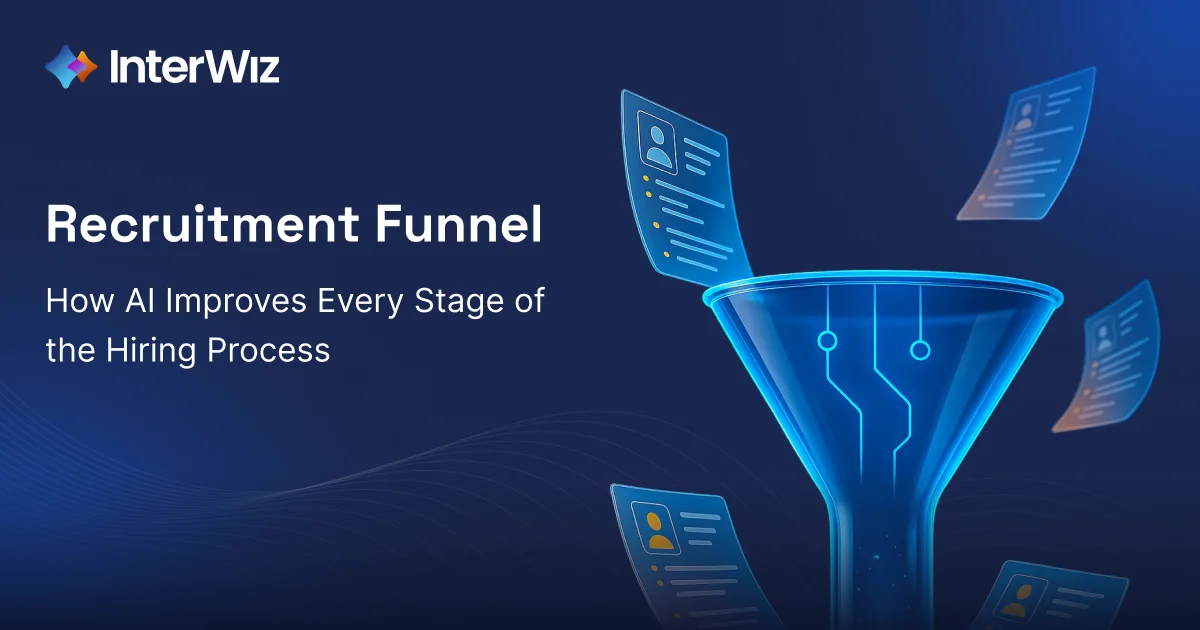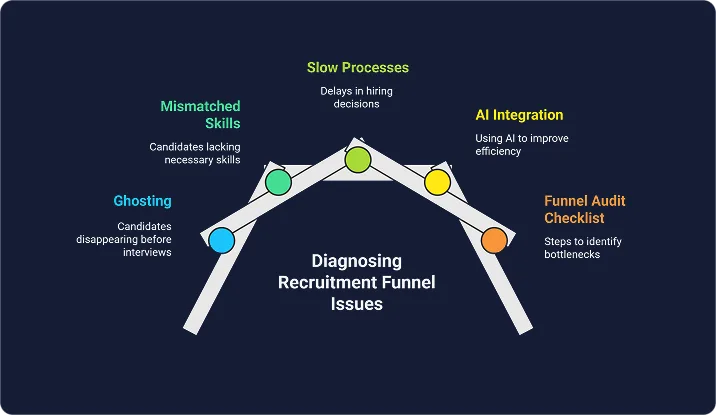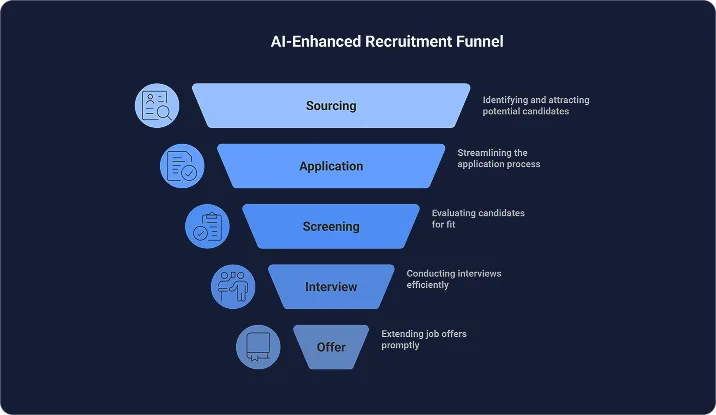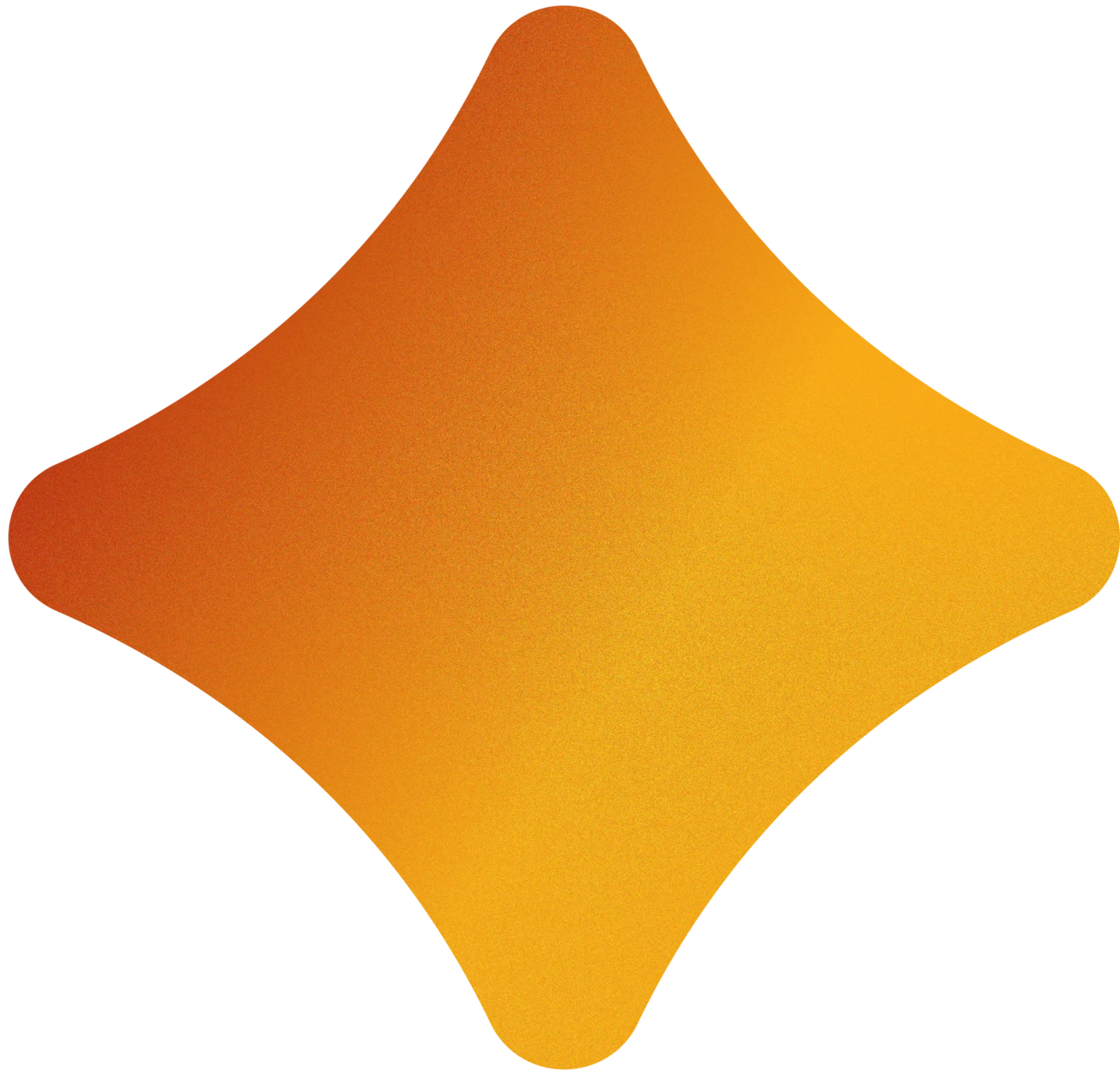JUMP TO SECTION
Hiring Best Practices | Future of Hiring
Rebuilding Your Recruitment Funnel With AI

Recruiting today feels like a race you can’t quite win. You’re juggling hundreds of applications, candidates expect instant updates, and hiring managers want decisions yesterday. The old funnel, built for slower markets and fewer applicants, simply can’t keep up.
The result? Leaks at every stage. You lose strong candidates to ghosting, get stuck screening résumés that don’t match, or drag out interviews until competitors swoop in. Adding another job board or chatbot doesn’t fix it. It just makes the leaks run faster.
What you need isn’t a patch, it’s a rebuild. And that’s where AI comes in. Used deliberately, an AI recruitment funnel helps you source smarter, keep applicants engaged, move faster through interviews, and ensure the process feels fair.
This guide will walk you through how to rebuild your funnel stage by stage, from sourcing and applications to interviews and onboarding, and show where AI creates real value versus where it’s just hype.
Why Your Recruitment Funnel Feels Broken
Recruiting in 2025 doesn’t fail because you lack résumés. It fails because your recruitment funnel leaks talent at every stage. SHRM’s latest data shows nearly seven in ten organizations struggle to fill roles, but the bottleneck isn’t applications. It’s ghosting, mismatched skills, and processes so slow that top candidates lose patience.
You’ve seen it yourself. You post a role, line up a shortlist, and then half your candidates vanish before the interview. The ones who stay often need weeks of training. Instead of moving talent forward, your funnel is draining it away.
Why? Because the old funnel was built for a different hiring era, one with slower timelines and fewer candidate options. Today, applicants move quickly. If your funnel can’t keep up, they’ll choose a competitor who can.
That’s why the AI recruitment funnel is no longer optional. Without AI to diagnose bottlenecks, keep candidates engaged, and spot transferable skills, you’ll keep patching leaks with job ads while your best talent slips away.

Solution: Map Your Funnel Before Automating It
Too many teams adopt AI recruiting tools before knowing where the funnel is broken. If you don’t measure the leaks first, automation will simply magnify inefficiencies.
SHRM’s 2025 benchmarks show the median time‑to‑fill is about 45 days (up to 61 in big companies). Yet the major slowdowns rarely occur in interviews. They happen in approvals that take weeks, candidates who drop out early, or hiring managers who drag decisions. You won’t see those problems without tracking the basics.
Quick Funnel Audit Checklist
Before investing in automation, ask yourself:
How long from requisition approval to posting? If it takes weeks, no scheduling tool will make up for that lag.
What’s your application‑to‑interview ratio? If you screen hundreds of résumés for a handful of calls, your top‑of‑funnel is clogged.
Where are candidates dropping out? If half leave before the second round, the issue is engagement, not sourcing.
How many interviews per hire? If you need five or more rounds, the problem is your process, not your talent pool.
You don’t need AI everywhere. Aim it where the pain is highest.
Where to Start Once You’ve Mapped the Funnel
Once you know where the leaks are, you can start rebuilding. Let’s start at the very top, with how you attract and source candidates.

Top of Funnel: Build Awareness and Source Smarter
At the very top of the funnel, the pain is obvious: you spend hours skimming résumés that don’t fit, while high-potential candidates never even enter the process. Posting jobs everywhere only multiplies the noise.
This happens because sourcing still relies on volume. One-click apply makes it easy for hundreds to submit résumés in minutes, but more applications rarely mean better ones. At the same time, skilled candidates with adjacent experience often get ignored because their job titles don’t match your posting exactly.
An AI recruitment funnel flips this equation from quantity to quality:
Rediscover overlooked talent: AI sourcing tools can resurface silver medalists and past applicants who’ve already shown interest in your company.
Uncover adjacent skills: Instead of filtering only by titles or keywords, AI tools recognize transferable skills that point to high-potential hires.
Personalize outreach: Rather than sending generic blasts, AI tools tailor messages to each candidate’s background, improving response rates and keeping engagement high.
Refine sourcing strategy: By analyzing which channels consistently bring in quality applicants, AI tools help you invest in what works instead of spreading efforts thin.
The top of your funnel isn’t measured by résumé count. It’s measured by the strength of the candidates who actually engage. This is the first step in building an AI recruitment funnel that starts with quality, not clutter.
Mid-Funnel: Simplify Applications and Improve Screening
By the time candidates reach your application or first screen, many have already lost patience. Long forms, clunky systems, and silence after applying cause drop-offs. Strong candidates walk away, while your team spends time on résumés that don’t match.
The issue is that most processes are built for internal convenience, not candidate experience. Applications are too long. Many systems don’t work well on mobile. And without consistent updates, applicants feel like their résumés went into a black hole.
An AI recruitment funnel strengthens the middle by reducing friction and surfacing genuine fit:
Streamlined applications with conversational forms that adapt to responses.
Mobile-first simplicity through AI parsing that auto-fills fields from résumés or profiles.
Automated engagement with timely reminders and updates that keep candidates warm.
Early fit signals from AI-driven assessments or one-way interviews that measure skills and potential, not just résumé keywords.
Takeaway: Fixing the mid-funnel isn’t about adding more filters. It’s about removing friction and using AI to focus your time on the candidates most likely to succeed.
Bottom of Funnel: Accelerate Interviews, Offers, and Onboarding
By the time candidates reach interviews, you’ve already invested heavily. But this is where many funnels break. Offers are delayed, top candidates accept elsewhere, and weeks of effort are wasted.
Here, the problem isn’t candidate interest; it’s team inefficiency. Scheduling drags for days. Panels overlap on the same questions. Managers hesitate, asking for “just one more round.” All of this signals disorganization to candidates, who quickly lose confidence.
An AI recruitment funnel keeps the final stretch decisive by fixing team-side bottlenecks:
Instant scheduling that aligns calendars in hours instead of days.
Fewer, sharper interviews with a structured design that avoids redundancy.
Prepared hiring teams with AI-generated question guides and candidate summaries.
Faster alignment via AI-powered reports that help managers make confident choices sooner.
Smooth onboarding with automated workflows that handle contracts, tasks, and pre-start engagement.
Takeaway: At the bottom of the funnel, momentum is everything. AI ensures interviews, decisions, and onboarding happen quickly and clearly, so you close the best talent before competitors do.
Trust, Ethics, and the Human Element
Speed and efficiency matter, but they’re not enough. Candidates also want to know the process is fair. If your funnel feels like a black box where decisions are made by algorithms alone, trust erodes, and the best candidates walk away.
Surveys show most job seekers are wary of companies that rely heavily on AI tools without transparency. Many fear bias or a lack of human judgment. The reality is, if your recruitment funnel feels impersonal or opaque, you’ll lose the very talent you worked hard to attract.
An AI recruitment funnel builds trust when it’s designed with fairness and accountability in mind:
Be transparent: Tell candidates when the AI tool is part of the process and how results are reviewed. A simple explanation goes a long way.
Audit for bias: Don’t assume vendors handle this. Regularly check your tools’ outputs to make sure certain groups aren’t being unfairly filtered.
Keep humans in the loop: AI tools should shortlist and structure decisions, not replace judgment. Final calls should always rest with recruiters.
Track candidate sentiment: Drop-off rates, response times, and candidate feedback are early signals of whether your process feels fair.
This is why InterWiz was built to keep recruiters in control. AI standardizes interviews and reduces bias, but every candidate's report is reviewed by humans before moving forward. Candidates also receive timely, structured feedback so the process feels fair, even if they don’t get the job.
Bottom Line: Rebuilding the recruitment funnel with Intention
AI won’t fix a broken funnel by itself; it will accelerate whatever process you feed it. That’s why the first step is to map where your funnel leaks, then rebuild stage by stage.
At the top, AI helps you start with better candidates instead of drowning in résumés. In the middle, it removes friction so applicants stay engaged. At the bottom, it speeds up interviews and decisions so you don’t lose talent to delays. And throughout, transparency and human oversight ensure the process is trusted as well as efficient.
That’s the foundation of a true AI recruitment funnel: not speed for speed’s sake, but a process that respects candidates, sharpens recruiter focus, and delivers stronger hires.
This is exactly why InterWiz exists. From rediscovering overlooked candidates to running structured AI-led interviews to automating scheduling and reports, InterWiz helps recruiters plug funnel leaks without losing control. The result isn’t just faster hiring, it’s a recruitment funnel that earns trust, delivers quality, and scales with confidence.
FAQs about AI Recruitment Funnel
Will AI replace recruiters?
No. AI automates repetitive tasks like screening and scheduling, but recruiters remain essential for building relationships and making final decisions.
Which industries see the most benefit from AI recruiting?
Industries with large applicant pools or specialized skill needs, such as healthcare, finance, retail, hospitality, technology, and manufacturing, derive the greatest benefits because AI can quickly process high volumes and identify niche.
Are there legal requirements for using AI in hiring?
Yes. In New York City, employers must audit AI tools for bias within one year of use, post results publicly, and notify candidates about the tool at least ten business days in advance.
How should recruiters handle candidate data privacy?
Define what data you collect, how long it’s stored and who can access. Communicate this clearly to candidates, obtain explicit consent and allow them to review or delete their information.

High Quality Screening with AI Interviews
Automated interviews built for speed, scale, and accuracy.
🔥 Full features, no credit card required.